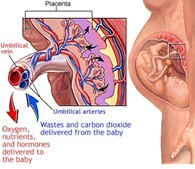Placental Insufficiency
Placenta doesn't deliver enough oxygen or food to the growing baby.
![]()
Placental Insufficiency |
 |
Placental Insufficiency During PregnancyContents • What Is Placental Insufficiency? |
|
|
What Is Placental Insufficiency?
Also called placental dysfunction, it is a complication of pregnancy whereby the placenta cannot deliver enough oxygen and nutrients to the growing baby. During pregnancy the fetus depends on the placenta and the umbilical veins for receiving oxygen and nutrients from the mother's blood, and for taking away carbon dioxide and other waste products. Because of the constancy of the mother's internal environment the composition of the blood reaching the placenta is unlikely to vary much except in rare conditions of maternal circulatory failure or asphyxia, or in cases of gross metabolic disturbance such as severe untreated diabetes or kidney disease. Even if the mother's diet is poor her blood will show little alteration, and this explains why a normal sized child may still be born to a mother with a bad diet. Fetal ill-health therefore seldom arises because of the quality of the mother's blood. If a problem arises, it is more likely to be due to a physical problem with the placenta itself.
Restriction of the mother's blood flow through the placenta is the most common cause of placental insufficiency. Any restriction can have a serious effect upon fetal growth and development. Placental damage can cause restriction - damage for example caused by infarction (tissue death) or the separation from the uterine wall (placenta abruption). Spasm or blood clots in the placenta veins also have the same effect. In a few patients who give birth to babies who have obviously suffered from chronic placental insufficiency the placenta is small for no apparent reason. If pregnancy progresses beyond the due date (known as postmaturity) the placenta sometimes becomes inadequate for the needs of the large, still growing fetus. Although intrauterine fetal death before the onset of labor is rare, fetal distress may occur during labor. Intrauterine death may occur in cases of diabetes but the cause of this is uncertain. The fetus is often very large, but so is the placenta, and placental failure is not an adequate explanation. In cases of hemolytic disease (where the mother and fetus' blood groups are not compatible) the placenta is large but the fetus probably dies from cardiac failure caused by the severe hemolytic anemia rather than from placental insufficiency.
Placental insufficiency usually does not produce any obvious symptoms, although there are certain clinical warning signs, namely inadequate: Mothers weight The mother's weight is taken at each prenatal visit, a below-average weight gain will be the first indication of a problem. Measuring the fundus height and observation of the baby during an ultrasound will give additional information. If it is suspected that the placenta is damaged further tests will be ordered. Treating the underlying condition, if it is diabetes, kidney disease or high blood pressure during pregnancy is important. You may be confined to bed for the rest of your pregnancy. If a serious problem is detected and the fetus is viable (able to live outside the womb), labor induction may be recommended. Expectations If the baby does not receive enough oxygen and nutrients, this can affect its growth. In some cases it leads to a very low weight in the baby, a condition called intrauterine growth restriction (IUGR). IUGR increases the risk of pregnancy and delivery complications.
|
| Related Articles on Pregnancy Problems
For more related complications, see the following: • Kidney infection during pregnancy: Signs, diagnosis and treatment. Back to Homepage: Womens Health Advice |
|
WOMENS HEALTH ADVICE: ABOUT PREGNANCY COMPLICATIONS |